 Discovering Invasive Plants
of Ketchikan
Discovering Invasive Plants
of Ketchikan
By Marie L. Monyak
April 24, 2006
Monday
Ketchikan, Alaska - Just in time for the spring planting season,
the Southeast Alaska Discovery Center Friday Night Insight Program
hosted the presentation; Invasive Plants in Ketchikan ~ Nip them
in the Bud! The guest speaker was Pam Fletcher, U.S. Forest Service
Ecologist for the Tongass National Forest.
With the assistance of a power point slide show, Fletcher began
by saying, "We're going to be talking about the invasive
plants in Ketchikan. I chose to take the 5 most common [plants]
seen around town."
Fletcher explained to the audience "Invasive plants have
become such a problem that in 1999, President Clinton issued
an executive order because the government realized that we were
having a problem because these plants are overrunning our country
so we need to control it."
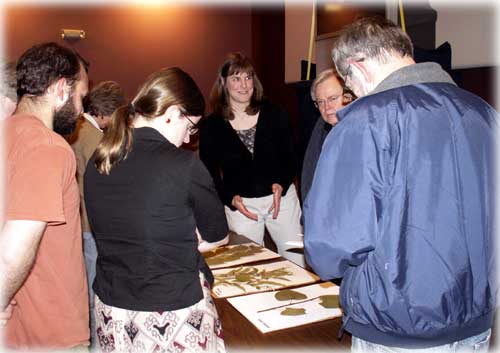 Pam Fletcher speaking
to audience members and answering their questions.
Pam Fletcher speaking
to audience members and answering their questions.
Photo by Marie L. Monyak
Realizing the need to define just what an invasive plant is,
Fletcher described them as, "Any plant that moves into a
new area by accident or on purpose, not from down the block or
from another state but from another country, not North America."
Fletcher added, "Also the plants are capable of moving into
native plant communities and disrupting the ecological processes
or they may cause harm to human health and incurs economic costs."
Fletcher showed several slides of just such activity where several
invasive plants had overrun a widespread area. One slide that
clearly depicted the problem was of Orange Hawkweed that had
taken over an entire meadow on Kodiak Island.
Explaining the necessity of knowing how the weeds or invasive
plant reproduce is the key to eradicating them. Fletcher said,
"How they spread is by seed, roots and stems and they are
very, very good at spreading. Invasive plants are spread by clothing,
shoes, cars, airplanes, hay and nurseries."
Looking a bit embarrassed, Fletcher admitted that even the U.S.
Forest had inadvertently introduced an invasive plant in Southeast
Alaska when they planted canary grass for the purpose of soil
stabilization but it backfired when the grass took over.
Asking the audience why they should care about these plants,
Fletcher answered her own question by saying, "They cause
a great deal of harm to our resources and take over native plant
communities and it costs a great deal to control them."
She further explained, "They have a real ecological impact
displacing native plants including rare and endangered species."
Fletcher displayed large dried samples of the 5 most common invasive
plants in Ketchikan and along with the slides; the audience was
able to recognize the most of the plants from their own yards
or areas they frequent.
According to Fletcher the most common invasive plants in Ketchikan
are Japanese Knotweed (4 different species), Orange Hawkweed,
Bull Thistle, Oxeye Daisy and Tansy Ragwort.
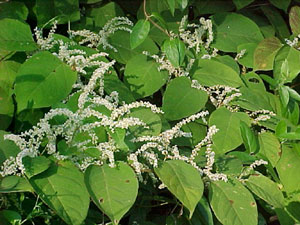 |
Japanese Knotweed (4 different
species)
Perennial, reproduces by roots. Only herbicides will eradicate.
Photographer: Britt Slattery,
U.S. Fish and Wildlife Service
|
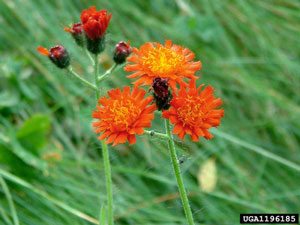 |
Orange Hawkweed
Perennial, reproduces by roots, runners and seeds
Remove by digging up entire plant.
Photographer: UAF Cooperative
Extension Archives, University of Alaska - Fairbanks
|
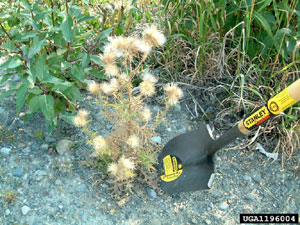 |
Bull Thistle
Biennial, Lives only 2 years
Remove by pulling out entire plant. Very thorny, wear gloves!
Photographer: UAF Cooperative
Extension Archives, University of Alaska - Fairbanks
|
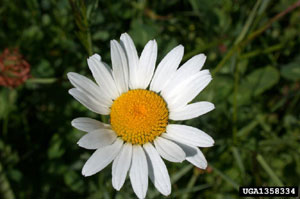 |
Oxeye Daisy
Perennial, reproduces by roots and seed. Remove by digging up
entire plant.
Photographer: Mary Ellen (Mel)
Harte
|
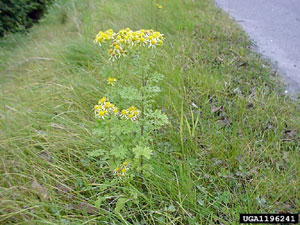 |
Tansy Ragwort
Perennial, reproduces by seed. Remove by digging up entire plant.
Toxic plant, wear gloves!
Photographer: Faith Duncan,
USDA Forest Service
|
Several slides that Fletcher presented showed areas around the
state that had been overrun by the various plants she had mentioned.
One of the biggest problems Fletcher explained is when the plants
grow along a waterway where the leaf litter ends up in the creek
or stream and various insects that are not native to the waterway
begin to live off the rotting vegetation. In the natural order
of things, our native fish begin to eat the insects which can
have an adverse effect, disrupting the natural cycle.
Another problem Fletcher pointed out was obvious in her next
slide, a vast area near a waterway had been invaded and as she
pointed out, it's difficult to eradicate because herbicides cannot
be used near the water. The next photo that had been taken in
Juneau showed how prolific Japanese Knotweed is, a grown man
in the center of the photo appeared to be practically swallowed
alive by the plants!
Fletcher ended her short presentation to allow time for questions
from the audience. The most important question she answered was
how to dispose of the plants once they were dug up. She recommended
enclosing the plants in plastic bags and taking them to the landfill
to be placed in the incinerator to prevent the plants from spreading.
When asked what type of herbicide she would recommend Fletcher
explained that there are too many variables such as the type
of soil, terrain, location and plant species to suggest any one
chemical although she did suggest contacting the University of
Alaska website for more information on eradication methods and
herbicides.
As Fletcher ended her presentation she invited the audience to
join her in the front of the room to inspect the samples she
had provided and to select from the numerous free Forest Service
pamphlets and brochures containing valuable information on invasive
plants.
The Southeast Alaska Discovery Center will have their last Friday
Night Insight Program of this season on April 28th. The next
Friday Night Insight Program season will begin in the fall.
The presentation on April 28,
held at 7:00 P.M., will be "The Nature of Wilderness."
Susan Bliss Jenkins, lead Wilderness Kayak Ranger for the Ketchikan
Misty Fiords Ranger District will highlight the differences and
similarities of three unique wilderness areas in the United States;
Juniper Prairie Wilderness in Florida, Gospel Hump Wilderness
in Idaho, and Misty Fiords National Monument in Alaska.
On the Web:
A cooperative project between
the USFS State and Private Forestry, the National Park Service,
Alaska Natural Heritage Program, University of Alaska Anchorage
and the USGS Alaska Science Center
http://akweeds.uaa.alaska.edu/
Marie L. Monyak is a freelance writer living in Ketchikan, Alaska.
A freelance writer is an uncommitted independent writer
from whom a publisher, such as SitNews, can order articles for
a fee.
For information about freelance writing services and costs contact
Marie at mlmx1[at]hotmail.com
Send your story ideas
to editor@sitnews us
Publish A Letter on SitNews Read Letters/Opinions
Contact the Editor
SitNews
Stories In The News
Ketchikan, Alaska
|






